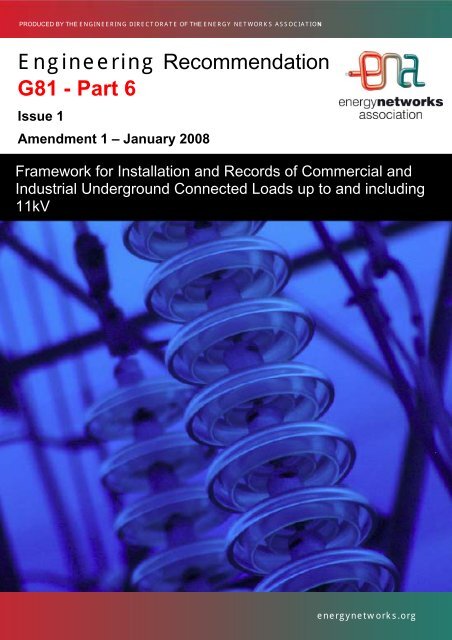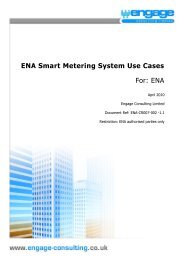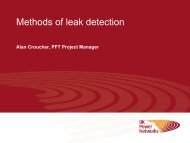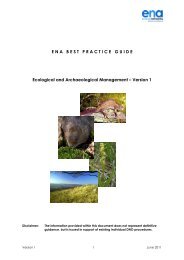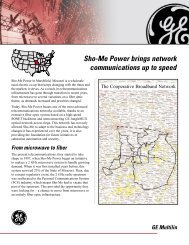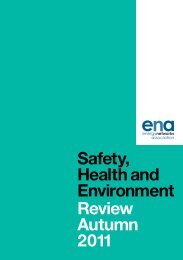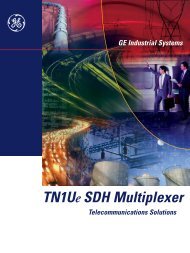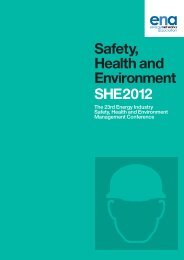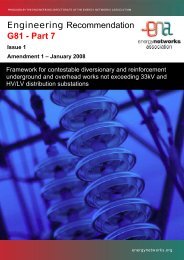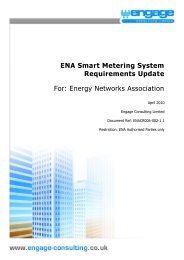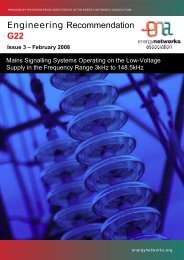Engineering Recommendation G81 - Part 6 - Energy Networks ...
Engineering Recommendation G81 - Part 6 - Energy Networks ...
Engineering Recommendation G81 - Part 6 - Energy Networks ...
Create successful ePaper yourself
Turn your PDF publications into a flip-book with our unique Google optimized e-Paper software.
PRODUCED BY THE ENGINEERING DIRECTORATE OF THE ENERGY NETWORKS ASSOCIATION<br />
<strong>Engineering</strong> <strong>Recommendation</strong><br />
<strong>G81</strong> - <strong>Part</strong> 6<br />
Issue 1<br />
Amendment 1 – January 2008<br />
Framework for Installation and Records of Commercial and<br />
Industrial Underground Connected Loads up to and including<br />
11kV<br />
energynetworks.org
© 2008 <strong>Energy</strong> <strong>Networks</strong> Association<br />
All rights reserved. No part of this publication may be<br />
reproduced, stored in a retrieval system or transmitted in any<br />
form or by any means, electronic, mechanical, photocopying,<br />
recording or otherwise, without the prior written consent of<br />
<strong>Energy</strong> <strong>Networks</strong> Association. Specific enquiries concerning this<br />
document should be addressed to:<br />
<strong>Engineering</strong> Directorate<br />
<strong>Energy</strong> <strong>Networks</strong> Association<br />
18 Stanhope Place<br />
Marble Arch<br />
London<br />
W2 2HH<br />
This document has been prepared for use by members of the<br />
<strong>Energy</strong> <strong>Networks</strong> Association to take account of the conditions<br />
which apply to them. Advice should be taken from an<br />
appropriately qualified engineer on the suitability of this<br />
document for any other purpose.
© <strong>Energy</strong> <strong>Networks</strong> Association 2008<br />
<strong>Engineering</strong> <strong>Recommendation</strong> <strong>G81</strong> <strong>Part</strong> 6 Issue 1<br />
Summary of Amendments:<br />
Amendment 1: January 2008<br />
Reference to Electricity and Pipe Line Works (assessment of environmental<br />
effects) Regulations removed<br />
Reference to Electricity Works (Environmental Impact Assessment) (England and<br />
Wales) Regulations changed to refer to the document amended in 2007<br />
Reference to Electricity Safety Quality and Continuity Regulations 2002 changed to<br />
refer to document amended in 2006.
ENA <strong>Engineering</strong> <strong>Recommendation</strong> <strong>G81</strong> Pt6 Issue 1<br />
Amendment 1: January 2008<br />
Page 2 of 16<br />
CONTENTS<br />
1 BACKGROUND ................................................................................................... 3<br />
2 SCOPE ............................................................................................................. 3<br />
3 REFERENCES ..................................................................................................... 4<br />
3.1 <strong>Energy</strong> <strong>Networks</strong> Association / ESI publications.............................................. 4<br />
3.2 <strong>Energy</strong> <strong>Networks</strong> Association Technical Specifications (ENATS) ......................... 4<br />
3.3 National Joint Utilities Group (NJUG) publications ......................................... 4<br />
3.4 Health & Safety Executive (HSE) publications ................................................ 5<br />
3.5 Pooling & Settlement Agreement ................................................................. 5<br />
3.6 Ofgem approved publications....................................................................... 5<br />
3.7 British Standards ....................................................................................... 5<br />
4 LEGISLATION.................................................................................................... 5<br />
5 DEFINITIONS and ABBREVIATIONS....................................................................... 7<br />
6 INTRODUCTION ................................................................................................. 8<br />
7 INSTALLATION.................................................................................................. 8<br />
7.1 General .................................................................................................... 8<br />
7.2 Underground cables ................................................................................... 8<br />
7.3 Plant.......................................................................................................10<br />
7.4 Service entries..........................................................................................11<br />
7.5 Multi- occupancy dwellings ........................................................................11<br />
7.6 Work in contaminated land.........................................................................13<br />
8 RECORDS ........................................................................................................14<br />
9 TESTS.............................................................................................................14<br />
APPENDIX A: TEST REQUIREMENTS.............................................................................15<br />
APPENDIX B: HOST DLH REQUIREMENTS – Typical Example Only......................................16<br />
2
ENA <strong>Engineering</strong> <strong>Recommendation</strong> <strong>G81</strong> Pt6 Issue 1<br />
Amendment 1: January 2008<br />
Page 3 of 16<br />
1 BACKGROUND<br />
a. This document was agreed by the Ofgem Electricity Connections Steering Group on<br />
October 12 th 2004. This revision extends the scope to include previously developed<br />
(“brownfield”) sites as well as the “Greenfield” sites previously covered.<br />
b. If there are queries about this document please discuss them with the Host DLH in<br />
whose area it is proposed that work is to be undertaken. In the event that it is not<br />
possible to resolve the question with the Host DLH, please seek advice from<br />
Connections Policy Team, Ofgem, 9 Millbank, London SW1P 3GE.<br />
2 SCOPE<br />
a. This document sets the installation and record requirements for low voltage, 6.6kV<br />
and 11kV underground industrial and commercial connections, including their new<br />
associated HV and HV/LV distribution substations. It is one of the following suite<br />
of documents governing this work:<br />
• Adoption Agreement<br />
• Design and Planning framework ( ER <strong>G81</strong> <strong>Part</strong> 4 )<br />
• Materials Specifications framework (ER <strong>G81</strong> <strong>Part</strong> 5)<br />
• Installation and Records framework (ER <strong>G81</strong> <strong>Part</strong> 6 )<br />
• Underground unmetered connections framework<br />
b. This document must be read in conjunction with these documents as some issues,<br />
for example equipment ratings, are dependent both on specification and the manner<br />
in which their use is designed or installed.<br />
c. For requirements relating to underground connected housing developments, see<br />
<strong>Engineering</strong> <strong>Recommendation</strong> <strong>G81</strong> parts 1, 2 and 3.<br />
NB This suite of documents applies only to NEW installations and is not to be<br />
applied retrospectively<br />
d. It is intended to set out or make reference to design and planning requirements<br />
which have to be met for a Host DLH to adopt contested HV and LV networks and<br />
their associated new HV and HV/LV distribution substations supplying industrial and<br />
commercial loads connected up to and including 11kV.<br />
e. This document is intended to supplement but not amend, abridge or override any<br />
legislation referred to within this document.<br />
3
ENA <strong>Engineering</strong> <strong>Recommendation</strong> <strong>G81</strong> Pt6 Issue 1<br />
Amendment 1: January 2008<br />
Page 4 of 16<br />
3 REFERENCES<br />
This document makes reference to the documents listed below, which must be<br />
complied with unless otherwise agreed in writing with the DLH. The latest editions<br />
of these documents including all addenda and revisions shall apply unless otherwise<br />
agreed with the DLH.<br />
3.1 <strong>Energy</strong> <strong>Networks</strong> Association / ESI publications<br />
ENA documents can be obtained via the ENA web site: www.energynetworks.org<br />
<strong>Engineering</strong> <strong>Recommendation</strong>s (ER)<br />
G12/3 Requirements for the application of protective multiple earthing to low<br />
voltage<br />
networks<br />
G17/3 Leakage of flammable gases recommendations<br />
G39/1 Model code of practice covering electrical safety in the planning<br />
installation commissioning and maintenance of public lighting and<br />
other street furniture<br />
3.2 <strong>Energy</strong> <strong>Networks</strong> Association Technical Specifications (ENATS)<br />
ENATS 12-03<br />
ENATS 12-23<br />
ENATS 12-24<br />
ENATS 37-2<br />
ENATS 41-24<br />
Outdoor meter cupboards<br />
Polythene protection tape for buried electricity supply cable<br />
Plastic ducts for buried electric cable<br />
LV distribution fuseboards<br />
Guidelines for the design, installation, testing and<br />
maintenance of main earthing systems in substations.<br />
3.3 National Joint Utilities Group (NJUG) publications<br />
NJUG 4<br />
NJUG 7<br />
NJUG 10<br />
The identification of small buried mains and services<br />
Recommended positioning of Utilities apparatus for new work on new<br />
developments and in existing streets<br />
Guidelines for the planning, installation and maintenance of utility<br />
services in proximity to trees.<br />
4
3.4 Health & Safety Executive (HSE) publications<br />
ENA <strong>Engineering</strong> <strong>Recommendation</strong> <strong>G81</strong> Pt6 Issue 1<br />
Amendment 1: January 2008<br />
Page 5 of 16<br />
HS (G) 47<br />
GS 6<br />
Avoiding danger from underground services<br />
Avoidance of danger from overhead electric power lines<br />
3.5 Pooling & Settlement Agreement<br />
Agreed Procedure – Unmetered Supplies Registered in PRS Vol 5 AP 520 Issue 3 -<br />
now BSCP 520.<br />
3.6 Ofgem approved publications<br />
Distribution Code<br />
Distribution Licence Conditions<br />
3.7 British Standards<br />
BS 7671<br />
Requirements for Electrical Installations (IEE Wiring Regulations 16 th<br />
edition)<br />
4 LEGISLATION<br />
All requirements of all relevant legislation must be met. The following is a list of<br />
some of the relevant legislation:<br />
Ancient Monuments and Archaeological Areas Act 1979<br />
Asbestos at Work Regulations 2002<br />
Building Regulations (and its related current Approved Documents)<br />
Confined spaces regulations 1997<br />
Construction (Design Management) Regulations 1994<br />
Construction Health, Safety & Welfare Regulations<br />
Contaminated Land (England) Regulations 2000<br />
Control of Substances Hazardous to Health Regulations 1999<br />
5
ENA <strong>Engineering</strong> <strong>Recommendation</strong> <strong>G81</strong> Pt6 Issue 1<br />
Amendment 1: January 2008<br />
Page 6 of 16<br />
EC Utilities Directive 93/38/EEC and UK SI 1996 No 2911<br />
Electricity Act 1989 as amended by the Utilities Act 2000; and the Distribution Code which is<br />
given legal authority by the provisions of the Public Electricity Supply Licence issued under<br />
it.<br />
Electricity Safety Quality and Continuity Regulations 2002 as amended 2006 (and associated<br />
Guidance issued by the DTI)<br />
Electricity at Work Regulations 1989<br />
Electricity Works (Environmental Impact Assessment) (England & Wales)<br />
Regulations 2000, as amended 2007<br />
Environmental Protection Act 1990 & 1995<br />
EU Habitats Directive 92/43/EEC – Special Areas of Conservation<br />
Fire Precautions Act 1971<br />
Fire Precautions (Workplace Regulations 1997 as amended 1999)<br />
Health & Safety at Work etc Act 1974<br />
Land Drainage Act 1991<br />
Lifting Operations and Lifting Equipment Regulations 1998<br />
Management of Health & Safety at Work Regulations 1999<br />
Manual Handling Operations Regulations 1992<br />
New Roads and Street Works Act and all related Codes of Practice and<br />
Specifications<br />
Noise at Work Regulations 1989<br />
Provision and Use of Work Equipment Regulations 1998<br />
Town & Country Planning Act – General Development Order 1990<br />
Water Resources Act 1991<br />
Wildlife and Countryside Act 1981<br />
Workplace Health, Safety and Welfare Regulations<br />
6
ENA <strong>Engineering</strong> <strong>Recommendation</strong> <strong>G81</strong> Pt6 Issue 1<br />
Amendment 1: January 2008<br />
Page 7 of 16<br />
5 DEFINITIONS AND ABBREVIATIONS<br />
OFGEM<br />
ADMD<br />
Applicant<br />
BSI<br />
BS<br />
BS EN<br />
Office of Gas and Electricity Markets<br />
After Diversity Maximum Demand<br />
The Company wishing to undertake the contestable work<br />
British Standards Institution<br />
British Standard<br />
A European Standard adopted as a British Standard<br />
CDM Construction (Design Management) Regulations 1994<br />
CNE<br />
Applicant<br />
DLH<br />
DSA<br />
EA<br />
ENATS<br />
ENA<br />
ER<br />
ESQCRs<br />
HD<br />
Host DLH<br />
Housing<br />
development<br />
HSE<br />
IEC<br />
NRSWA<br />
PSCC<br />
Combined neutral and earth (of cable construction)<br />
The Company wishing to undertake the contestable work<br />
Distribution Licence Holder – defined in Standard Licence<br />
Conditions for Electricity Distributors, issued under the Utilities Act<br />
and effective from 1 st Sept. 2001<br />
Distribution Service Area – the service area of a DLH<br />
Electricity Association ( replaced by ENA for <strong>Networks</strong> issues post<br />
Oct 2003)<br />
<strong>Energy</strong> <strong>Networks</strong> Association Technical Specification<br />
<strong>Energy</strong> <strong>Networks</strong> Association<br />
National <strong>Engineering</strong> <strong>Recommendation</strong> issued by ENA or EA<br />
Electricity Safety Quality and Continuity Regulations 2002, as<br />
amended 2006 (and their associated Guidance documents issued by<br />
DTI)<br />
Harmonised Document (IEC standard adopted as a European<br />
reference document)<br />
The DLH in whose licensed area (DSA) the works are to take place<br />
A development consisting of domestic dwellings<br />
Health & Safety Executive<br />
International Electrotechnical Commission<br />
New Roads and Street Works Act<br />
Prospective Short Circuit Current<br />
7
ENA <strong>Engineering</strong> <strong>Recommendation</strong> <strong>G81</strong> Pt6 Issue 1<br />
Amendment 1: January 2008<br />
Page 8 of 16<br />
6 INTRODUCTION<br />
a. This framework describes installation test and records requirements for low voltage,<br />
6.6kV and 11kV underground industrial and commercial connections, including their<br />
new associated HV and HV/LV distribution substations.<br />
b. This document is subject to some local variation between DLHs because, for<br />
example, of differences in:<br />
• substation specification<br />
• environment and impact on ratings, insulation, corrosion etc<br />
• compatibility with existing equipment<br />
c. Where a deviation from this framework is identified, it will be stated in the<br />
Appendices to this Technical Framework document.<br />
7 INSTALLATION<br />
7.1 General<br />
a. The installation of all plant and equipment to be adopted by the Host DLH shall<br />
meet the requirements of the listed references, all applicable legislation and the<br />
details in this section. It must be noted that ratings will be influenced by the<br />
installation arrangement and reference shall be made to the “Design and planning<br />
requirements framework” document (ER <strong>G81</strong> <strong>Part</strong> 4 and Appendices) regarding<br />
equipment ratings.<br />
b. All plant and equipment installed shall comply with the requirements of the<br />
“Materials specification framework” document.<br />
c. The installation shall be such as to permit future live low voltage working on the<br />
asset by the Host DLH.<br />
7.2 Underground cables<br />
a. There shall be no material change to routes (to the extent that it affects design<br />
criteria) detailed in previously submitted plans unless otherwise agreed in writing<br />
with the Host DLH and other interested parties.<br />
b. Cable laying depths shall be as NJUG 7, unless otherwise agreed, and shall be<br />
recorded.<br />
8
ENA <strong>Engineering</strong> <strong>Recommendation</strong> <strong>G81</strong> Pt6 Issue 1<br />
Amendment 1: January 2008<br />
Page 9 of 16<br />
c. Trenches shall be prepared so that the bottom of the trench is free of rubble, sharp<br />
stones, flint etc., and an adequate layer of stone dust or other suitable bedding has<br />
been laid. Where a change of level is necessary, the bottom of the trench shall rise<br />
or fall gradually.<br />
d. Ducts shall be laid at least 300 mm below the carriageway construction and shall<br />
extend to the outer extremities of the kerb haunchings. Checks shall be made that<br />
all installed ducts are undamaged and are not obstructed (including any ducts laid<br />
as spare for future use). Duct mouths shall be sealed to prevent ingress of water,<br />
noxious or explosive liquids or gases. Ducts shall be suitably spaced to avoid<br />
congestion at either end to facilitate future jointing. Spare ducts shall be installed<br />
by the Applicant at positions agreed with the Host DLH.<br />
e. Wherever possible, cables should be laid by hand. If a winch is employed to pull the<br />
cable, rollers and skid plates shall be used in the trench to ensure that the cable<br />
does not touch the ground during pulling. A cable stocking, fitted with a swivel,<br />
must be used to connect the bond to the cable and a dynamometer used to check<br />
that the maximum pulling tension for the cable is not exceeded.<br />
f. Cable laying shall only take place when the ambient temperature is above 0º C and<br />
has been above this temperature for the previous 24 hours. Alternatively, special<br />
precautions shall be taken to maintain cables above this temperature to avoid risk<br />
of damage during handling.<br />
g. Cables shall not be bent further than their minimum bending radius.<br />
h. The cable shall be correctly spaced from other cables and other utility services, in<br />
accordance with NJUG specifications.<br />
i. Earth conductors and rods shall be laid in accordance with the previously submitted<br />
plans. Note should be taken of the requirements of ESQC Regulation 9 (2) (a) on the<br />
need for earths at the remote end of the main, during each stage of the<br />
energisation programme.<br />
j. Before backfilling a visual inspection shall be carried out to ensure the cable is free<br />
from damage. After laying the cable shall be backfilled with suitable graded fine fill<br />
material to tape level and the correct marker tape laid, in compliance with The<br />
Electricity Safety Quality and Continuity Regulations 2002 and Host DLH policy.<br />
k. Jointing materials comply with Host DLH specification or an agreed equivalent.<br />
l. Jointing practice shall be in accordance with a specification agreed with the Host<br />
DLH.<br />
9
ENA <strong>Engineering</strong> <strong>Recommendation</strong> <strong>G81</strong> Pt6 Issue 1<br />
Amendment 1: January 2008<br />
Page 10 of 16<br />
m. Joints shall be made 'Colour True' or R - 1, Y - 2, B - 3, unless agreed otherwise with<br />
the Host DLH. DLHs are currently seeking to establish programmes with their cable<br />
suppliers for the managed introduction of the new European harmonised cable<br />
colours (Black, Brown, Grey phases with Blue Neutral). This should be discussed with<br />
the Host DLH.<br />
n. Cable terminations shall be made with correct phase connections.<br />
o. Service connections shall be made to the correct phase as shown on network<br />
drawings. The numbers of services taken from a single joint shall not exceed the<br />
number agreed with the Host DLH; that number being the maximum the Host DLH<br />
would accept for work undertaken directly on its own behalf.<br />
p. Where a DLH employs such a system, a unique permanent labelling system shall be<br />
applied to the joint giving the jointers name.<br />
q. The Applicant must provide a Completion Certificate, signed by the jointer, for each<br />
joint made. These shall be kept in the Construction File, together with copies of<br />
the inspection forms.<br />
7.3 Plant<br />
a. Specifications of HV/LV distribution substations and HV switchboards and other<br />
equipment such as protection, SCADA, and battery systems shall follow Host DLH<br />
standards detailed in Appendix B. This may include such issues as layout, enclosure<br />
type, Electricity Safety Quality and Continuity Regulations and associated Guidance<br />
security requirements, internal arc relief etc.<br />
b. LV ac supply arrangements to substations shall be agreed with the Host DLH.<br />
c. Requirements on batteries such as location, ventilation, type, sizing, life and<br />
nominal voltages shall be discussed with the Host DLH unless these are fully set out<br />
in Appendix B.<br />
d. Requirements for accuracy testing of metering CTs and VTs , certification and hand<br />
over of documentation need to be agreed at an early stage, having regard to the<br />
requirements of BSCP 520. Care is required to ensure necessary testing and<br />
certification requirements are met before CTs and VTs are built into equipment as<br />
long delays may otherwise be caused.<br />
e. Plant delivered from manufacturers shall be unloaded and stored in a way that<br />
avoids damage or exposure.<br />
f. The Host DLH shall supply plant and substation numbering signage, property<br />
ownership and Danger of Death signs prior to energisation.<br />
10
ENA <strong>Engineering</strong> <strong>Recommendation</strong> <strong>G81</strong> Pt6 Issue 1<br />
Amendment 1: January 2008<br />
Page 11 of 16<br />
7.4 Service entries<br />
a. Service entry policy may vary between DLH’s – see information in Appendix B of<br />
“Design and planning framework” document for details.<br />
b. Cavity service entry shall not normally permitted as this de-rates the service cable.<br />
c. If alternative arrangements are considered the following shall be taken into<br />
account:<br />
• The air temperature surrounding the cut out must not exceed 30 ° C.<br />
• All meter cabinets must be installed in a way that maintains the manufactured fire<br />
resistance values.<br />
d. Service ducting shall be installed from the service position to the point where the<br />
service cable will be jointed onto the main. The service cable shall be drawn by<br />
hand into this duct. Black duct shall be used for electrical service cables, to<br />
prevent confusion with other utility services.<br />
e. The Applicant shall provide phase marking on cut out terminals.<br />
7.5 Multi- occupancy dwellings<br />
a. The following additional clauses apply to installations for multi-occupancy<br />
premises such as offices, and shops. There are a number of different approaches<br />
which are employed in various DLH service areas on the design of connections to<br />
multi-occupancy premises. The following paragraphs describe the most common<br />
practices, not all will necessarily be accepted by Host DLH; refer to Appendix A for<br />
any Host DLH variations.<br />
b. LV cable entry to building – approved rigid black duct or fireclay duct with slow<br />
radius bend, minimum bending radius 900mm, 150mm inside diameter, with<br />
drawcord for each incoming mains cable to area clear of building and any<br />
concreted area, buried with minimum 450mm cover overlaid with marker tape and<br />
into drawpit in termination enclosure 700mmD, 1000mmL 450mmW. Some DLHs<br />
do not employ drawpits and use duct as described above to area clear of building<br />
and any concreted area.<br />
c. LV intake position accommodation - Developer to provide suitable secure and fire<br />
proof enclosure for cut out and distribution board (when required) in suitable<br />
common access location on ground floor minimising route length to exterior and<br />
which provides suitable cable routes, meter position and exit points for each<br />
dwelling.<br />
11
ENA <strong>Engineering</strong> <strong>Recommendation</strong> <strong>G81</strong> Pt6 Issue 1<br />
Amendment 1: January 2008<br />
Page 12 of 16<br />
d. Communal LV meter / service enclosures shall not be used for other purposes<br />
posing increased risk to equipment, risk of fire or risks to operatives. The size of<br />
the LV enclosure is dictated by the equipment installed and the need for adequate<br />
working space. There shall be a minimum of 300mm separation to any gas meter<br />
or gas pipe joints. The average temperature shall not exceed 30C.<br />
e. Where the building entrance is closed for security reasons or there is no<br />
alternative means of escape, the LV enclosure should be sited adjacent to an<br />
external wall and be accessible from outdoors. HV substations shall be arranged<br />
to be in a separate building or on an outside wall unless otherwise agreed with<br />
the Host DLH. Outside doors shall be lockable, weatherproof and vandal resistant.<br />
See Appendix B for Host DLH requirements on locks.<br />
f. Lateral connections:<br />
The developer is responsible for the design, construction and installation of the<br />
service cable routes within the building. The design route / cable length used to<br />
calculate voltage drop shall not be exceeded.<br />
g. Service cables must not be routed through individual (non common space)<br />
premises other than the one being served. Mains shall not be routed through<br />
premises. The routes selected within the building must ensure that after<br />
installation cables are accessible for withdrawal / replacement without damage to<br />
the building.<br />
h. Mains and service cables must not be in the same duct as non electrical services.<br />
Where not ducted it must be clipped to cable tray. Where a multi-service shaft is<br />
provided, the electrical installation must be compartmented to provide a fire<br />
barrier from the other services. Every vertical duct, shaft or trunk must have<br />
internal barriers to prevent excessive heat rise at the top. The maximum<br />
separation between barriers is 1 floor or 5 metres, whichever is less. After<br />
installation of cabling the developer shall carry out fire stopping using materials<br />
such as cement mortar, gypsum based plaster, cement or gypsum based<br />
vermiculite / perlite mixes, intumescent mastics, proprietary sealing systems,<br />
rockwool or as specified differently by the Host DLH in Appendix B. The method of<br />
ducting should be agreed with the Host DLH taking account of the derating factor<br />
of the current carrying capacity of the cables.<br />
i. If service or mains cables pass through a part of the building required to have a<br />
minimum fire resistance period, the installation must maintain the integrity of the<br />
fire resistance. Minimum fire resistance periods are listed in the Building<br />
Regulations, to which reference must be made.<br />
12
ENA <strong>Engineering</strong> <strong>Recommendation</strong> <strong>G81</strong> Pt6 Issue 1<br />
Amendment 1: January 2008<br />
Page 13 of 16<br />
j. LV Meter positions:<br />
1) Meter cabinets shall be fire resistant, and of a type approved by the Host<br />
DLH. Meter positions shall be accessible from communal areas. Meters should<br />
be positioned so that they are installed not less than 450mm and not more<br />
than 1800mm from the floor.<br />
2) Meter positions shall either be separated by 2 metres, effectively screened or<br />
effectively bonded against the risk of electric shock by simultaneous touch<br />
under earth fault conditions.<br />
3) LV group meters and switchgear must be clearly identified to the appropriate<br />
dwelling by a secure label supplied and installed by the Developer.<br />
k. Bonding:<br />
a. Bonding of electrical installations must be in accordance with BS 7671.<br />
The Developer shall ensure that PME bonding shall include bonding to<br />
metal services as close a possible to their point of entry into the building<br />
and to accessible steelwork.<br />
b. Each premises shall be regarded as separate and treated in the same way as<br />
individual houses, irrespective of any bonding carried out elsewhere, e.g.<br />
where communal services enter the building.<br />
7.6 Work in contaminated land<br />
Where work is to take place in contaminated land, special precautions will need to be<br />
established, to cover in particular, the following:<br />
• Prevention of the creation of pathways, for example by trenching, allowing the<br />
movement of contamination<br />
• Prevention of damage or reduction in normal life of assets as a result of<br />
contamination, e.g. by the removal of contamination, creation of barriers or use of<br />
specific resistant materials<br />
• The CDM file shall include: details of the contamination survey, worker risk mitigation<br />
both during installation and during subsequent service life to asset removal.<br />
13
ENA <strong>Engineering</strong> <strong>Recommendation</strong> <strong>G81</strong> Pt6 Issue 1<br />
Amendment 1: January 2008<br />
Page 14 of 16<br />
8 RECORDS<br />
a. It shall be the responsibility of the Applicant to provide the Host DLH with accurate records<br />
of the installation. These records shall include:<br />
• For all installed cables and joints: plans showing route, depth, cable types<br />
and sizes, ducts lengths and sizes, joint locations, joint and service phasing<br />
and earth rod location. (Note that there are also draft requirements set out<br />
in NRSWA Records Code of Practice )<br />
• For all installed plant and protection: location, maker, type, rating and serial<br />
numbers.<br />
b. The accuracy requirements and means by which plans are provided to the Host DLH shall be<br />
the same as would apply if the work was undertaken directly for the Host DLH. The Host DLH<br />
shall provide the Applicant with information in Appendix B to facilitate this.<br />
9 TESTS<br />
a. The Applicant shall perform tests on the complete installation to verify that it has<br />
been correctly installed, it is safe to energise and customers may be safely<br />
connected. Appendix A provides a list of typical test requirements.<br />
b. A programme of tests shall be agreed between Host DLH and Applicant in respect of<br />
HV equipment including HV protection and any remote control / automation /<br />
SCADA facilities. The extent of tests required and the format for recording test<br />
results will be specified by the Host DLH in Appendix B.<br />
14
ENA <strong>Engineering</strong> <strong>Recommendation</strong> <strong>G81</strong> Pt6 Issue 1<br />
Amendment 1: January 2008<br />
Page 15 of 16<br />
APPENDIX A: TEST REQUIREMENTS<br />
Each service<br />
- polarity / phase rotation (3ph)<br />
- insulation resistance 500/1000V<br />
- earth loop impedance<br />
Each new section of main - insulation resistance ph-ph and ph-n/earth 500/1000V<br />
- continuity<br />
Each p.m.e. electrode<br />
Earthing resistance<br />
- earth resistance<br />
- overall value measured at substation<br />
- at HV/LV substation – combined HV/LV / not<br />
combined and overlap (depends on achieving < 1<br />
Ohm)<br />
LV fuse cabinet - insulation resistance 500/1000V<br />
HV/LV transformer<br />
HV Switchgear<br />
HV Cables<br />
- insulation resistances HV- LV winding/earth<br />
- pressure test<br />
- voltage and phasing checks<br />
- tap setting check<br />
- oil moisture content<br />
- oil electric breakdown strength<br />
- statement on pcb content < 2ppm new oil<br />
- insulation resistance 5kV<br />
- pressure test<br />
- protection test, secondary injection or dummy HV fuse<br />
tester<br />
(e.g. B&S device)<br />
- functional test of interlocks and operation<br />
- insulation test any loose test devices<br />
- busbar resistance if work includes connection of busbars,<br />
new to new or new to existing<br />
- gas pressure if gas filled<br />
- insulation resistance 5kV<br />
- pressure test RYB-E, RY-B, BR-Y<br />
- continuity<br />
HV Protection<br />
- functional testing including injection testing<br />
- insulation resistance<br />
15
ENA <strong>Engineering</strong> <strong>Recommendation</strong> <strong>G81</strong> Pt6 Issue 1<br />
Amendment 1: January 2008<br />
Page 16 of 16<br />
APPENDIX B: HOST DLH REQUIREMENTS – Typical Example Only<br />
The following is only provided as an indication of the type of information which<br />
would be included by the Host DLH in this Appendix.<br />
Service entries<br />
Cavity service entry shall not normally be permitted as this de-rates the service<br />
cable.<br />
LV meter cabinet and installation arrangements shall be one of the type agreed with<br />
the<br />
Host DLH [ongoing need to hold spare doors etc]. These arrangements shall be<br />
agreed in advance and documented, with appropriate drawings.<br />
If alternative arrangements are considered the following shall be taken into<br />
account:<br />
The air temperature surrounding the cut out must not exceed 30 º c.<br />
All meter cabinets must be installed in a way that maintains the<br />
manufactured fire resistance values.<br />
HOST DLH REQUIREMENT - ASSET RECORDING – Typical only<br />
Principles of recording cables<br />
Taking measurements using triangulation<br />
Extended sight lines and right angles<br />
Chain Lines<br />
`<br />
Same feature recording<br />
Other data to be recorded on site<br />
Recording of cable sections<br />
Process of cable recording<br />
Example of cable sketch<br />
16


